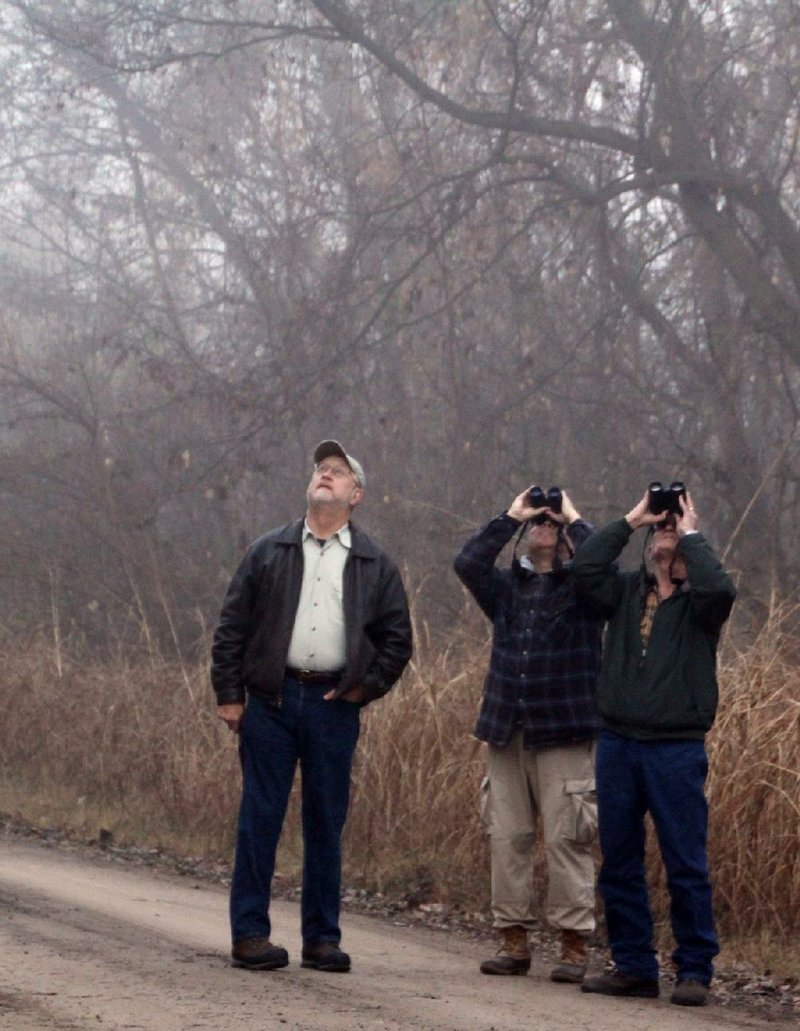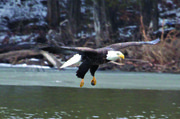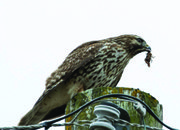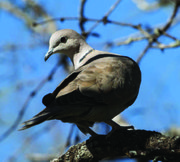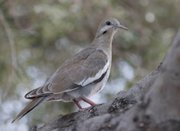FORT SMITH -- Thursday brings to a close the National Audubon Society's 117th Christmas Bird Count, billed as "the nation's longest-running citizen science bird project."
If this count has proceeded as those that came before, about 76,000 volunteers from the United States, Canada, Latin America, the Caribbean, Bermuda and the Pacific Islands will have conducted more than 2,500 counts since Dec. 14, seeing or hearing more than 2,600 species and 58 million individual birds.
Birding is a lifetime activity, and some of these people participate for decades. For example, Bill Beall of Fort Smith has led his local Christmas count for 66 years.
This annual census of populations known as "the CBC" observes birds in a rational manner. Anyone can volunteer to count, but volunteers must follow certain rules. These can be found on the Audubon website (audubon.org). However, a much more enjoyable way to learn about that is to call one of the contacts listed on the website and ask about joining a count in your area.
This was the process I followed, and it led me to Beall. He invited me to join his group.
Beall, who is also treasurer of the Northwest Arkansas Audubon Society, got his start leading CBC counts in 1951 while in 11th grade at Fort Smith Senior High School. He read about the count in Audubon Magazine, and its story impressed him.
Although conducted in the interest of wildlife conservation, the census was inspired by a tradition that today is considered senseless slaughter.
Before the 20th century, an annual feature of Christmas gatherings was the "side hunt." Hunters took sides and competed to return with the greatest number of dead carcasses, feathered or furred. The roots of the American tradition can be traced back to the United Kingdom's "match hunt."
[EMAIL UPDATES: Sign up for free breaking news alerts + daily newsletters with top headlines]
As the 19th century ended, ornithologist Frank M. Chapman, a dedicated hunter and an officer in the then-new
Audubon Society, became disgusted by the sheer waste of this annual massacre. He proposed an alternate contest. Instead of killing as many birds as possible, hunters should count them. He called his game the "Christmas Bird Census."
On Christmas Day 1900, 27 observers at 25 locations across the United States and Canada took up his proposal, recording more than 90 species and 18,000 individual birds.
Although not rigorously scientific, over the decades data collected by volunteers has helped scientists track long-range trends in bird populations and shifts in species' ranges.
Beall decided that Fort Smith should be part of that effort. To support his ambitious endeavor, Ruth Armstrong, of the Fort Smith Audubon Society chapter, agreed to drive him and three classmates to their assigned territory on the day they selected for their count. On that initial CBC, Beall's group recorded 41 species.
DARK AND COLD
I met Beall and fellow birders Jim Nieting of Fort Smith and Fillmore Dryden of Van Buren in the early morning dark at an entrance to Chaffee Crossing, near the city of Barling. After introductions all around, we drove along a dirt road into the densely wooded forest of Fort Chaffee, the former military training facility.
Our first stop was a stretch of road closely bordered on each side by thick underbrush and tall hardwood trees.
With Nieting having accompanied Beall on more than 40 CBCs, their routine was well rehearsed. Immediately after stepping out of Beall's Toyota 4Runner, they stood silently.
Beall later explained that one of the golden rules of birding is to observe a new area before venturing in. First identify by sound or sight whatever can be observed while standing still. This proved more helpful after daylight, especially as we approached a body of water.
We had arrived at this early hour to count owls. After silently listening and observing no owls for several minutes, we gathered behind the car.
At Beall's request, Nieting opened his iPad. He pressed a button and out came a recorded screech owl's call. He did this several times, then paused the recording to once again listen and observe.
With a nod from Beall, the recording was played once more.
From the distance came an answer. Silently, Nieting pointed in that direction. Beall nodded, whispering, "Screech owl."
After documenting that owl in his notebook, he quietly suggested we move to another spot. When we got there, the iPad routine was repeated.
Whatever the owl on the recording was saying must have been quite alluring, because soon we spotted a dark silhouette silently gliding through the bare tree branches with the bright moon as backdrop. An actual screech owl had arrived to check out this sweet-talking potential mate.
TECHNOLOGY!
Beall explained that birding has changed a lot since he first began observing birds some 72 years ago. In his youth, birders would thumb well-worn pages of hardback field guidebooks under the ever wiggling beam of a fellow birder's flashlight. It was years before the invention of portable tape recorders even gave birders the means to record a live call in the field to be used later to flush a bird.
Now, with the Audubon Bird Guide app at their fingertips, they have quick access to hundreds of calls and detailed species descriptions.
CIRCLES
Our group was optimistic that an approaching cold front would stimulate bird feeding activity. Beall explained that birds can sense a coming change in conditions up to 24 hours in advance. With the morning sun cresting the treetops, we loaded up once again to travel to a pair of manmade reservoirs.
Each individual CBC is performed within assigned territory -- a "count circle" with a diameter of 15 miles. Once a count circle has been established it cannot be changed, and no two circles will overlap.
This year the Fort Smith circle was shared by two groups. Volunteers headed up by Sandy Berger of Fort Smith performed the count north of the Arkansas River, while Beall's group was responsible for the remaining area to the south and west. But even with Berger's group helping, Beall still had a large territory to cover, so we had to keep moving.
Upon arriving at the reservoirs we quietly stepped from our vehicles to listen and observe. Beall pointed to a distant dark object in the sky.
"Red-tailed hawk," he said.
Swiftly, Nieting and Dryden trained their binoculars on the tiny speck, adding confirmation.
Dryden then pointed to a tiny object fluttering about in a bare thicket and pronounced it a field sparrow.
Astonished, I crossed a grassy field to approach Beall and ask him how they were able to identify the birds so easily. For me, the hawk had been a mere blip. There was no way I could have distinguished its species. I also wondered how they could swing their binoculars up so fast and locate a bird in their viewfinders without swerving.
Newcomers to this activity are eagerly welcomed into the birding community, and members are happy tutors. Beall smiled as he patiently explained that identifying birds from a distance and being able to quickly center them in binoculars were trained skills that birders acquire with practice.
He added that identifying birds is much like solving a puzzle. For a bird in flight, you observe its wing rhythm. Next, is it soaring or flapping its wings? If flapping its wings, how fast are they flapping?
Movement patterns, along with wing and body shape, tail traits and other characteristics, are pieces used in solving the puzzle.
"This is a part of what makes birding so much fun," he said.
A RUSH
The reservoir proved to be a goldmine for spotting species and tallying individual birds. At the far edge of the water, the group spotted a large flock of more than 40 shoveler ducks.
Beall zoomed his spotting scope in on a ring-billed gull so I was able to make out the source of its name, a black ring at the end of its beak, leaving a bright white speck at its tip.
As the men quietly continued counting and making notes, hundreds of frightened wings took to the air with a loud, fluttering swish.
Bill gestured overhead to a hovering shape: "Immature bald eagle."
FIELD WORKER
With our job completed at the reservoir, he led us to a stand of pine trees. We followed the tree line to an open prairie field. Next we walked along the outskirts of the field, following the south-facing brush. Beall explained that our reason for staying to the south side of the brush was that birds start their day here to catch the warmth of the rising sun.
We paused to look on as a mockingbird fought off a cardinal encroaching on a tree loaded with berries. The mockingbird had staked out the cache as its territory.
Next we slowly entered the chest-high, dry prairie tallgrass, occasionally scaring up tiny feeding birds -- each of which Beall dutifully recorded in his notebook.
Our route took us to a small pond that had been hidden by trees and thick brush, prime territory for adding numbers to the count.
The CBC rules stipulate that counting must be done in the same places in each circle year after year. Beall knows the best places, Dryden said, adding that when he moved to the area, he asked around and was told that Beall knew "where all the dead bodies were buried." So he joined his count.
After birding with Beall for just a few hours he could discover more species than he would on his own in an entire day.
The National Audubon Society has asked Beall to convert about 67 years worth of his handwritten field notes to a digital format so they can be loaded into the online eBird database. He has converted about half of these notes and already has more than 250,000 online entries to his credit.
After exiting Chaffee, the group traveled throughout the Fort Smith area, pausing at various birding hot spots that Beall knew.
We ended our day just past 5 p.m. in Oklahoma, deep in the Arkansas River bottoms. The forecast cold front had arrived, and bird activity was minimal. Our feathered friends preferred to nestle in the warmth of the thick grass or brush, which felt like a good idea to me, too.
All in all, considering weather, Beall called it a good CBC, with 87 different species and 23,023 individual bird sightings.
By spring, the Fort Smith circle's data will have been combined with reports from all the other circle counts in Arkansas (the website lists 27 circles) and loaded into the database, making them available for anyone to see and use.
Those results will be reported at audubon.org.
ActiveStyle on 01/02/2017
